Temporal–Spatial Distributions and Influencing Factors of Heavy Metals As, Cd, Pb, and Zn in Alluvial Soils on a Regional Scale in Guangxi, China
Abstract
:1. Introduction
2. Materials and Methods
2.1. Study Area
2.2. Sampling and Analysis Method
2.2.1. Materials and Sampling
2.2.2. Sample Preparation and Laboratory Analysis
2.3. Factor Selection
2.4. Random Forest Algorithm
3. Results
3.1. Descriptive Statistics
3.2. Spatiotemporal Distributions of Heavy Metals
4. Discussion
5. Conclusions
Author Contributions
Funding
Acknowledgments
Conflicts of Interest
References
- Arfaeinia, H.; Dobaradaran, S.; Moradi, M.; Pasalari, H.; Mehrizi, E.A.; Taghizadeh, F.; Esmaili, A.; Ansarizadeh, M. The effect of land use configurations on concentration, spatial distribution, and ecological risk of heavy metals in coastal sediments of northern part along the Persian Gulf. Sci. Total Environ. 2019, 653, 783–791. [Google Scholar] [CrossRef] [PubMed]
- Liu, H.; Zhang, Y.; Yang, J.; Wang, H.; Li, Y.; Shi, Y.; Li, D.; Holm, P.; Ou, Q.; Hu, W. Quantitative source apportionment, risk assessment and distribution of heavy metals in agricultural soils from southern Shandong Peninsula of China. Sci. Total Environ. 2021, 767, 144879. [Google Scholar] [CrossRef] [PubMed]
- Wu, W.; Wu, P.; Yang, F.; Sun, D.; Zhang, D.; Zhou, Y. Assessment of heavy metal pollution and human health risks in urban soils around an electronics manufacturing facility. Sci. Total Environ. 2018, 630, 53. [Google Scholar] [CrossRef] [PubMed]
- Yang, Q.; Li, Z.; Lu, X.; Duan, Q.; Lei, H.; Bi, J. A review of soil heavy metal pollution from industrial and agricultural regions in China: Pollution and risk assessment. Sci. Total Environ. 2018, 642, 690–700. [Google Scholar] [CrossRef] [PubMed]
- Zhang, C.; Yang, Y. Modeling the spatial variations in anthropogenic factors of soil heavy metal accumulation by geographically weighted logistic regression. Sci. Total Environ. 2020, 717, 137096. [Google Scholar] [CrossRef] [PubMed]
- Wen, Y.; Li, W.; Yang, Z.; Zhuo, X.; Guan, D.; Song, Y.; Guo, C.; Ji, J. Evaluation of various approaches to predict cadmium bioavailability to rice grown in soils with high geochemical background in the karst region, southwestern China. Environ. Pollut. 2020, 258, 113645. [Google Scholar] [CrossRef] [PubMed]
- Sullivan, P.L.; Macpherson, G.L.; Martin, J.B.; Price, R.M. Evolution of carbonate and karst critical zones. Chem. Geol. 2019, 527, 119–223. [Google Scholar] [CrossRef]
- Li, Z.; Ma, Z.; Kuijp, T.J.; Yuan, Z.; Huang, L. A review of soil heavy metal pollution from mines in China: Pollution and health risk assessment. Sci. Total Environ. 2014, 468–469, 843–853. [Google Scholar] [CrossRef]
- Li, P.; Zhi, Y.; Shi, J.; Zeng, L.; Wu, L. County-scale temporal-spatial distribution and variability tendency of heavy metals in arable soils influenced by policy adjustment during the last decade: A case study of Changxing, China. Environ. Sci. Pollut. Res. 2015, 22, 17937–17947. [Google Scholar] [CrossRef]
- Nickel, S.; Hertel, A.; Pesch, R.; Schroder, W.; Steinnes, E.; Uggerud, H. Modelling and mapping spatio-temporal trends of heavy metal accumulation in moss and natural surface soil monitored 1990-2010 throughout Norway by multivariate generalized linear models and geostatistics. Atmos. Environ. 2014, 99, 85–93. [Google Scholar] [CrossRef]
- Rodríguez Martín, J.A.; De Arana, C.; Ramos-Miras, J.J.; Gil, C.; Boluda, R. Impact of 70 years urban growth associated with heavy metal pollution. Environ. Pollut. 2015, 196, 156–163. [Google Scholar] [CrossRef] [PubMed]
- Shukla, L.; Jain, N. A review on soil heavy metals contamination: Effects, sources and remedies. Appl. Ecol. Environ. Sci. 2022, 10, 15–18. [Google Scholar] [CrossRef]
- Tian, M.; Wang, X.; Liu, F.; Hu, Q.; Qiao, Y.; Wang, Q. Spatial-temporal variability and influence factors of Cd in soils of Guangxi, China. PLoS ONE 2023, 18, e0279980. [Google Scholar] [CrossRef] [PubMed]
- Xie, X.J.; Cheng, H.X. The suitability of floodplain sediment as a global sampling medium: Evidence from China. J. Geochem. Explor. 1997, 58, 51–62. [Google Scholar] [CrossRef]
- Xie, X.J.; Ma, X.Z.; Ren, T.X. Geochemical mapping in China. J. Geochem. Explor. 1997, 60, 99–113. [Google Scholar]
- Wang, X. Global Geochemical Baselines: Understanding the past and predicting the future. Earth Sci. Front. 2012, 19, 7–18, (In Chinese with English Abstract). [Google Scholar]
- Wang, X.Q. China geochemical baselines: Sampling methodology. J. Geochem. Explor. 2015, 148, 25–39. [Google Scholar] [CrossRef]
- Wang, X.; Zhou, J.; Xu, S.; Chi, Q.; Nie, L.; Zhang, B.; Yao, W.; Wang, W.; Liu, H.; Liu, D.; et al. China soil geochemical baselines networks: Data characteristics. Geol. China 2016, 43, 1469–1480, (In Chinese with English Abstract). [Google Scholar]
- Tian, M.; Wang, X.; Qiao, Y.; Liu, D.; Chi, Q.; Liu, H.; Wang, W.; Zhang, B. Temporal Variations of Sediment Provenance in a Karst Watershed, China. Appl. Sci. 2023, 13, 771. [Google Scholar] [CrossRef]
- Karim, Z.; Qureshi, B.A.; Mumtaz, M.; Salmon, Q. Heavy metal content in urban soils as an indicator of anthropogenic and natural influences on landscape of Karachid A multivariate spatio-temporal analysis. Ecol. Indic. 2014, 42, 20–31. [Google Scholar] [CrossRef]
- Wong, S.C.; Li, X.; Zhang, G.; Qi, S.; Min, Y. Heavy metals in agricultural soils of the pearl River Delta, south China. Environ. Pollut. 2002, 119, 33–44. [Google Scholar] [CrossRef] [PubMed]
- Sparks, D.L. Environmental Soil Chemistry, 2nd ed.; Academic Press: San Diego, CA, USA, 2003. [Google Scholar]
- Cheng, W.; Yang, Z.F.; Cong, Z.; Ji, J.F. Temporal-spatial variation and source apportionment of soil heavy metals in the representative river-alluviation depositional system. Environ. Pollut. 2016, 216, 18–26. [Google Scholar]
- Liang, S.Y.; Cui, J.L.; Bi, X.Y.; Luo, X.; Li, X. Deciphering source contributions of trace metal contamination in urban soil, road dust, and foliar dust of Guangzhou, southern China. Sci. Total Environ. 2019, 695, 133596.1–133596.12. [Google Scholar] [CrossRef] [PubMed]
- Ren, S.; Song, C.; Ye, S.; Cheng, C.; Gao, P. The spatiotemporal variation in heavy metals in China’s farmland soil over the past 20 years: A meta-analysis. Sci. Total Environ. 2022, 806, 150322. [Google Scholar] [CrossRef] [PubMed]
- Breiman, L. Random forests. Mach. Learn. 2001, 45, 5–32. [Google Scholar] [CrossRef]
- Cracknell, M.J.; Reading, A.M.; Mcneill, A.W. Mapping geology and volcanic-hosted massive sulfide alteration in the Hellyer-Mt Charter region, Tasmania, using Random Forests™ and Self-organising maps. J. Geol. Soc. Aust. 2014, 61, 287–304. [Google Scholar] [CrossRef]
- Wiesmeier, M.; Steffens, M.; Kölbl, A.; Knabner, I. Degradation and small-scale spatial homogenization of topsoils in intensively grazed steppes of Northern China. Soil Tillage Res. 2009, 104, 299–310. [Google Scholar] [CrossRef]
- Carranza, E.J.M.; Laborte, A.G. Random forest predictive modeling of mineral prospectivity with small number of prospects and data with missing values in Abra (Philippines). Comput. Geosci. 2015, 74, 60–70. [Google Scholar] [CrossRef]
- Darnley, A.G.; BjorklundJ, A.; Boviken, B. A Global Geochemical Database for Environmental and Resource Management: Final Report of IGCP Project 259, Earth Sciences, 19; UNESCO Publishing: Paris, France, 1995; 122p. [Google Scholar]
- Lark, R.M.; Bellamy, P.H.; Rawlins, B.G. Spatio-temporal variability of some metal concentrations in the soil of eastern England, and implications for soil monitoring. Geoderma 2006, 133, 363–379. [Google Scholar] [CrossRef]
- Zhang, Q.; Bai, J.; Wang, Y. Analytical scheme and quality monitoring system for China Geochemical Baselines. Earth Sci. Front. 2012, 19, 33–42, (In Chinese with English Abstract). [Google Scholar]
- Xie, X.J.; Yan, M.C.; Li, L.Z.; Shen, H. Usable values for Chinese standard reference samples of stream sediments, soils, and rocks: GSD 9–12, GSS 1–8 and GSR 1–6. Geostand. Newsl. 1985, 9, 277–280. [Google Scholar]
- Breiman, L. Bagging predictors. Mach. Learn. 1996, 24, 123–140. [Google Scholar] [CrossRef]
- Tian, M.; Wang, X.; Nie, L.; Liu, H.; Wang, W.; Yan, T. Spatial distributions and the identification of ore-related anomalies of Cu across the boundary area of China and Mongolia. J. Geochem. Explor. 2019, 197, 37–47. [Google Scholar] [CrossRef]
- Team, R.R.D.C. A language and environment for statistical computing. Computing 2007, 1, 12–21. [Google Scholar]
- Yang, T.; Han, G. Characteristics of heavy metals in soils under different land use in a typical karst area, southwest China. Acta Geochim. 2017, 36, 515–518. [Google Scholar]
- Shu, X.; Li, Y.; Li, F.; Feng, J.; Shen, J.; Shi, Z. Impacts of land use and landscape patterns on heavy metal accumulation in soil. Environ. Sci. 2019, 40, 2471–2482, (In Chinese with English Abstract). [Google Scholar]
- Liu, L.L.; Liu, Q.Y.; Ma, J.; Wu, H.; Qu, Y.; Gong, Y.; Yang, S.; An, Y.; Zhou, Y. Heavy metal(loid)s in the topsoil of urban parks in Beijing, China: Concentrations, potential sources, and risk assessment. Environ. Pollut. 2020, 260, 114083. [Google Scholar] [CrossRef]
- Gao, Y.F.; Liu, H.L.; Liu, G.X. The spatial distribution and accumulation characteristics of heavy metals in steppe soils around three mining areas in Xilinhot in Inner Mongolia, China. Environ. Sci. Pollut. Res. 2017, 24, 16–25, (In Chinese with English Abstract). [Google Scholar] [CrossRef]
- Solgi, E.; Parmah, J. Analysis and assessment of nickel and chromium pollution in soils around Baghejar Chromite Mine of Sabzevar Ophiolite Belt, Northeastern Iran. Trans. Nonferrous Met. Soc. China 2015, 25, 2380–2387. [Google Scholar] [CrossRef]
- Qiao, P.W.; Yang, S.C.; Lei, M. Quantitative analysis of the factors influencing spatial distribution of soil heavy metals based on geographical detector. Sci. Total Environ. 2019, 664, 392–413. [Google Scholar] [CrossRef]
- Wang, P.; Wang, S.L.; Liu, S.Q.; Li, Y.; He, M.; Lin, X. Occurrence, speciation, source and geochemical cycle of Arseni. Environ. Sci. Technol. 2010, 7, 96–103, (In Chinese with English Abstract). [Google Scholar]
- Bo, Y.; Luo, L.Q. Geochemical characteristics and research direction of Arsenic. Rock Miner. Anal. 2009, 28, 569–575, (In Chinese with English Abstract). [Google Scholar]
- Li, Z.; Xu, X.; Zhang, Y.; Wang, K. Fingerprinting sediment sources in a typical karst catchment of southwest China. Int. Soil Water Conserv. Res. 2020, 8, 277–285. [Google Scholar] [CrossRef]
- Guan, Z.; Tang, X.Y.; Yang, J.E.; Ok, Y.S.; Xu, Z.; Nishimura, T.; Reid, B.J. A review of source tracking techniques for fine sediment within a catchment. Environ. Geochem. Health 2017, 39, 1–23. [Google Scholar] [CrossRef]
- Zhang, X.; Yan, Y.; Wadood, S.A.; Sun, Q.; Guo, B. Source apportionment of cadmium pollution in agricultural soil based on cadmium isotope ratio analysis. Appl. Geochem. 2020, 123, 104776. [Google Scholar] [CrossRef]
- Zhu, H.Y.; Jin, H.; Liu, R. Lead and its variation in wet deposition of Qingdao. Environ. Monit. China 2001, 17, 45, (In Chinese with English Abstract). [Google Scholar]
- He, B.; Zhao, X.; Li, P.; Liang, J.; Fan, Q.; Ma, X.; Zheng, J.; Qiu, J. Lead isotopic fingerprinting as a tracer to identify the pollution sources of heavy metals in the southeastern zone of Baiyin, China. Sci. Total Environ. 2019, 660, 348–357. [Google Scholar] [CrossRef] [PubMed]
- Su, Z.; Wen, X.F.; Wu, P.; Liu, H.; Liu, Y.; Pan, Q.; Wei, X.; Wu, S. Excessive Degrees and Migration Characteristics of Heavy Metals in Typical Weathering Profiles in Karst Areas. Earth Environ. 2019, 47, 53–59, (In Chinese with English Abstract). [Google Scholar]
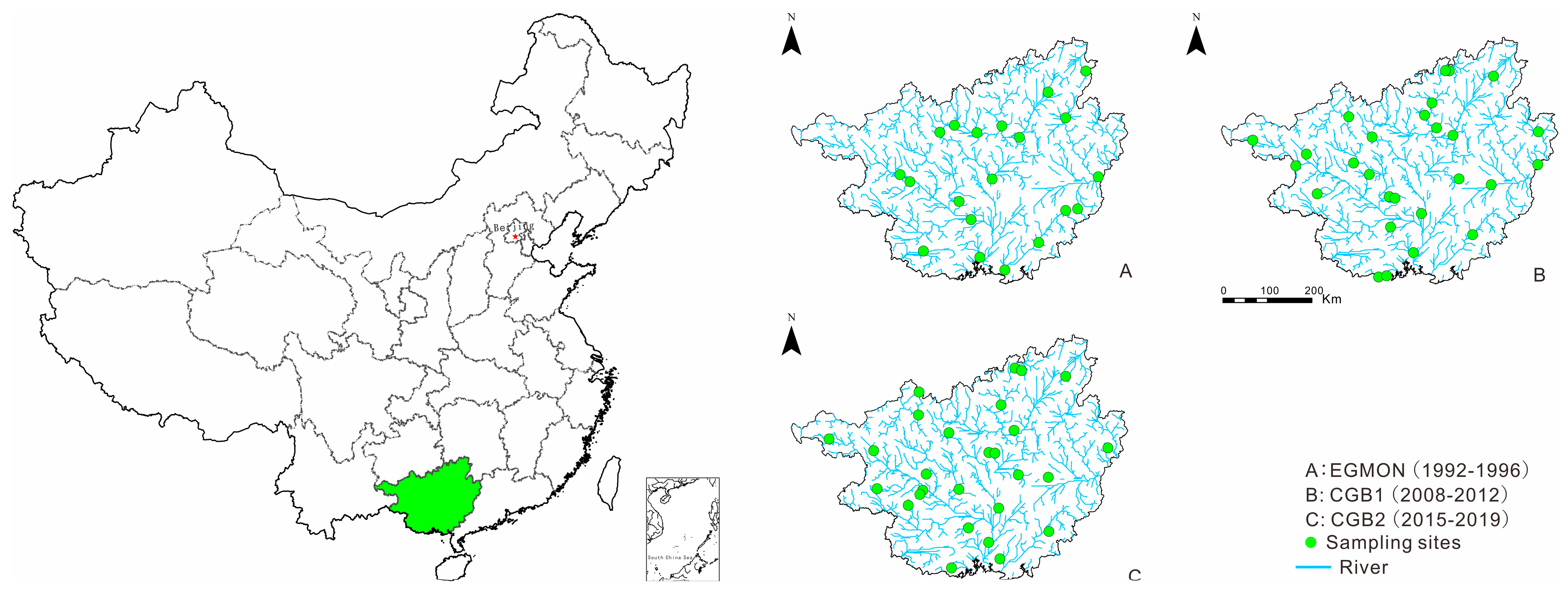

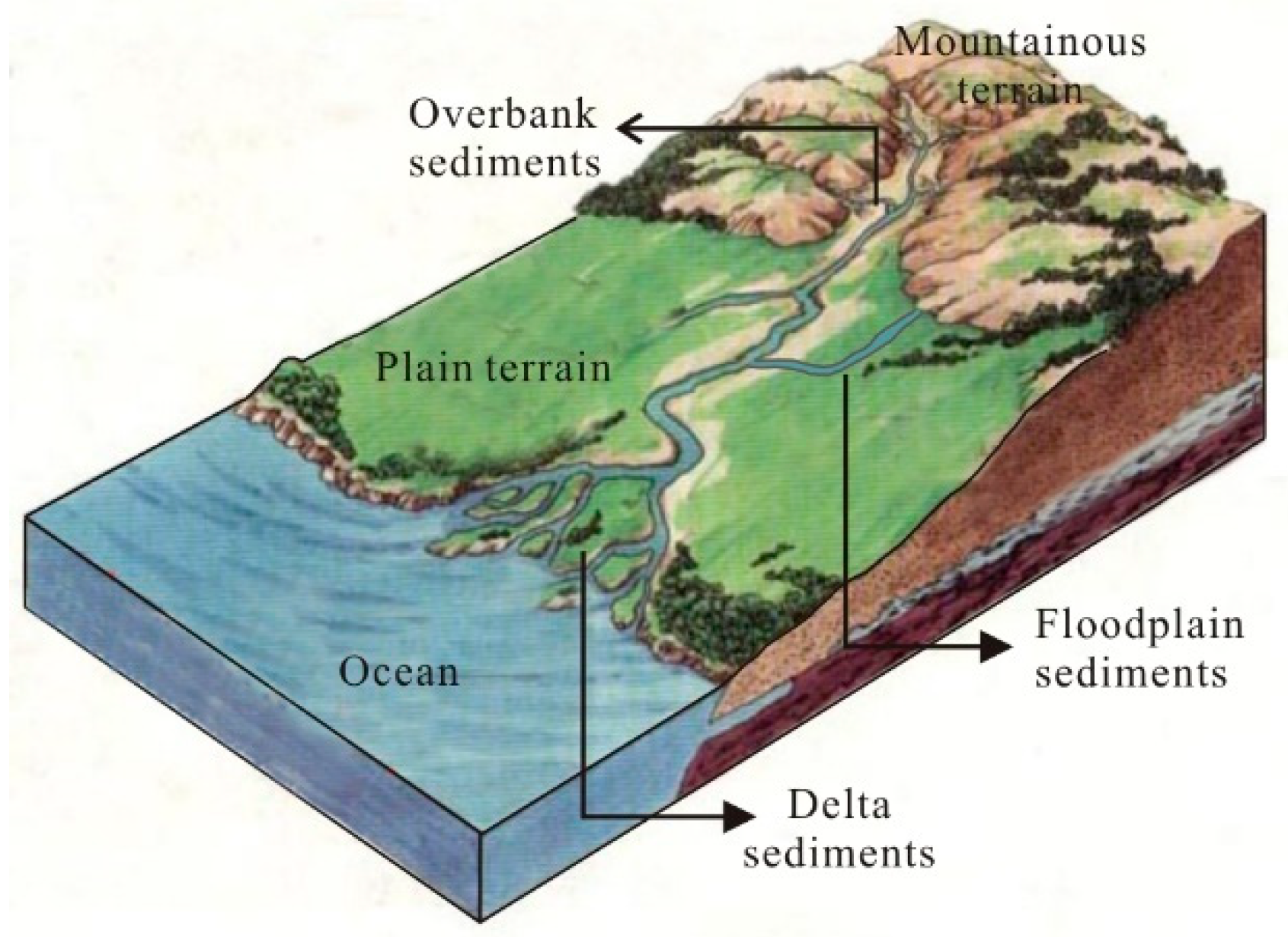
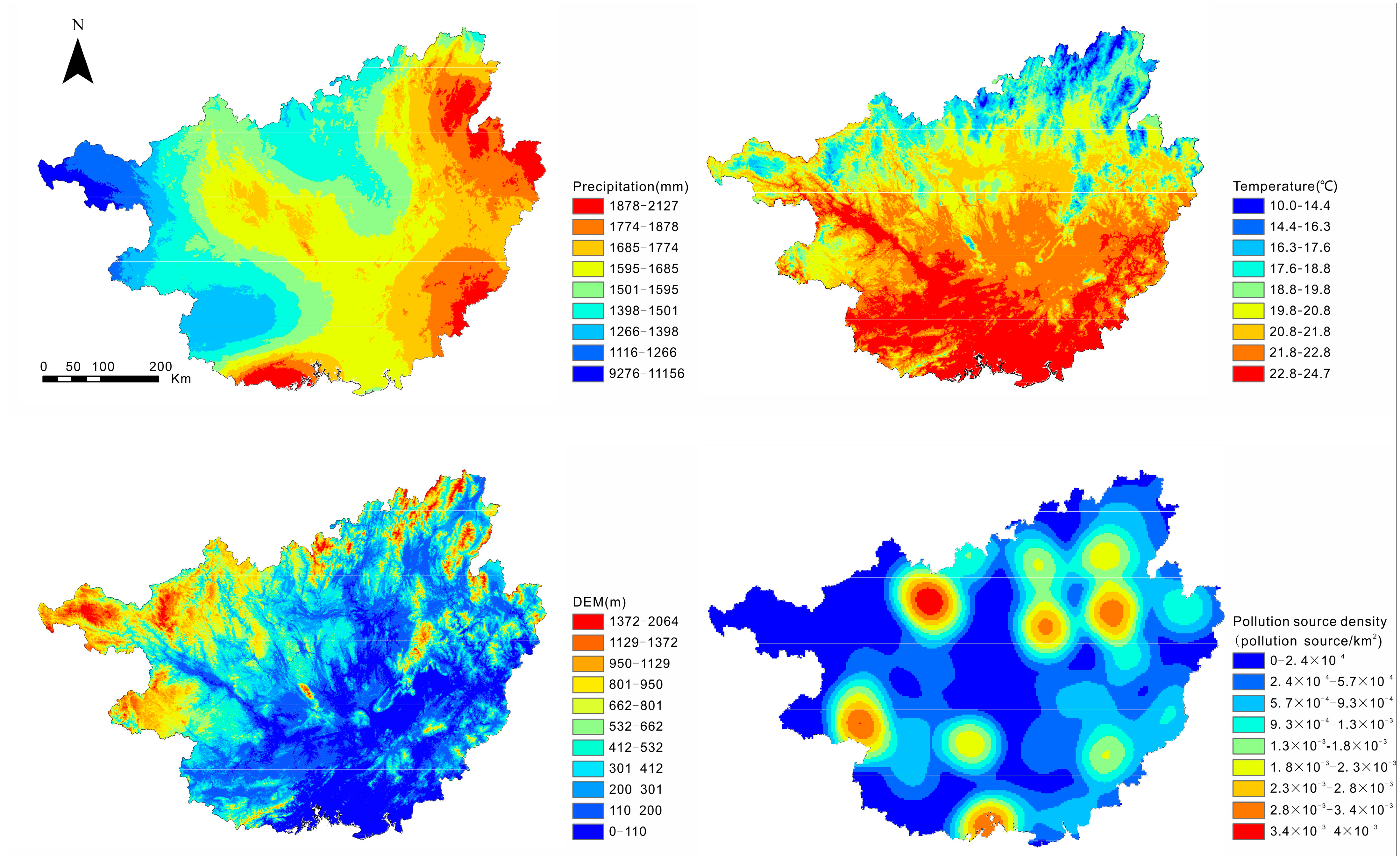



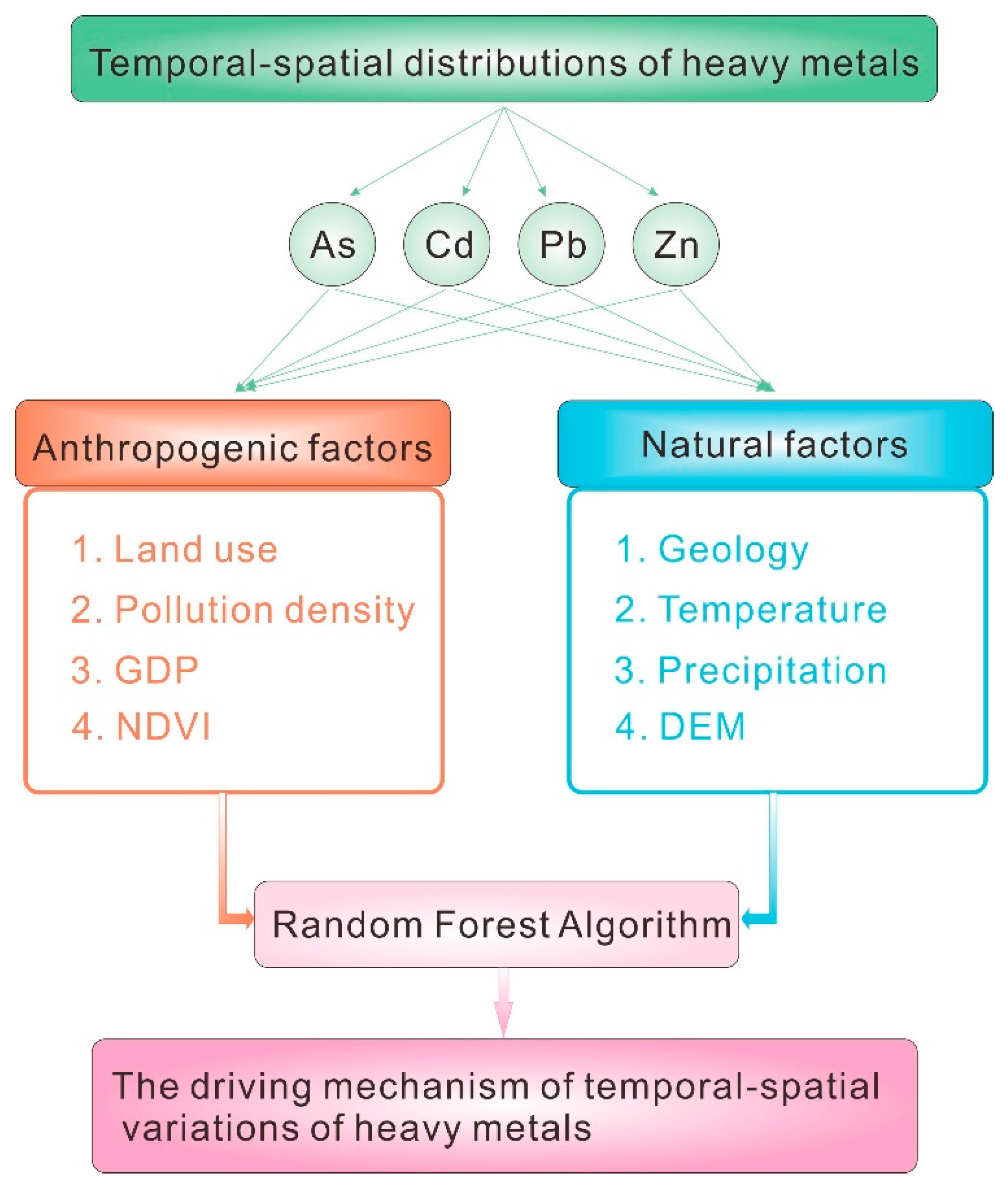
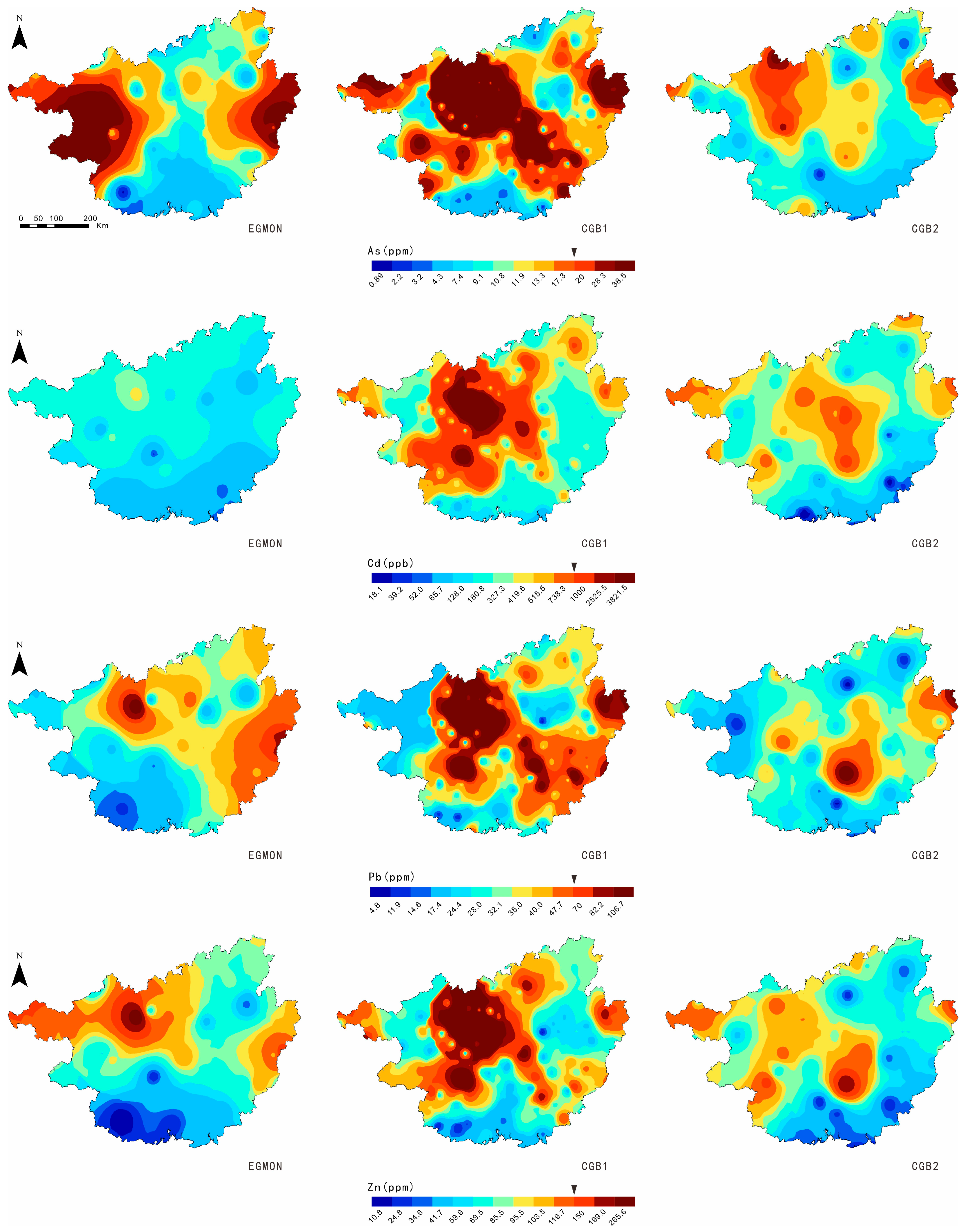
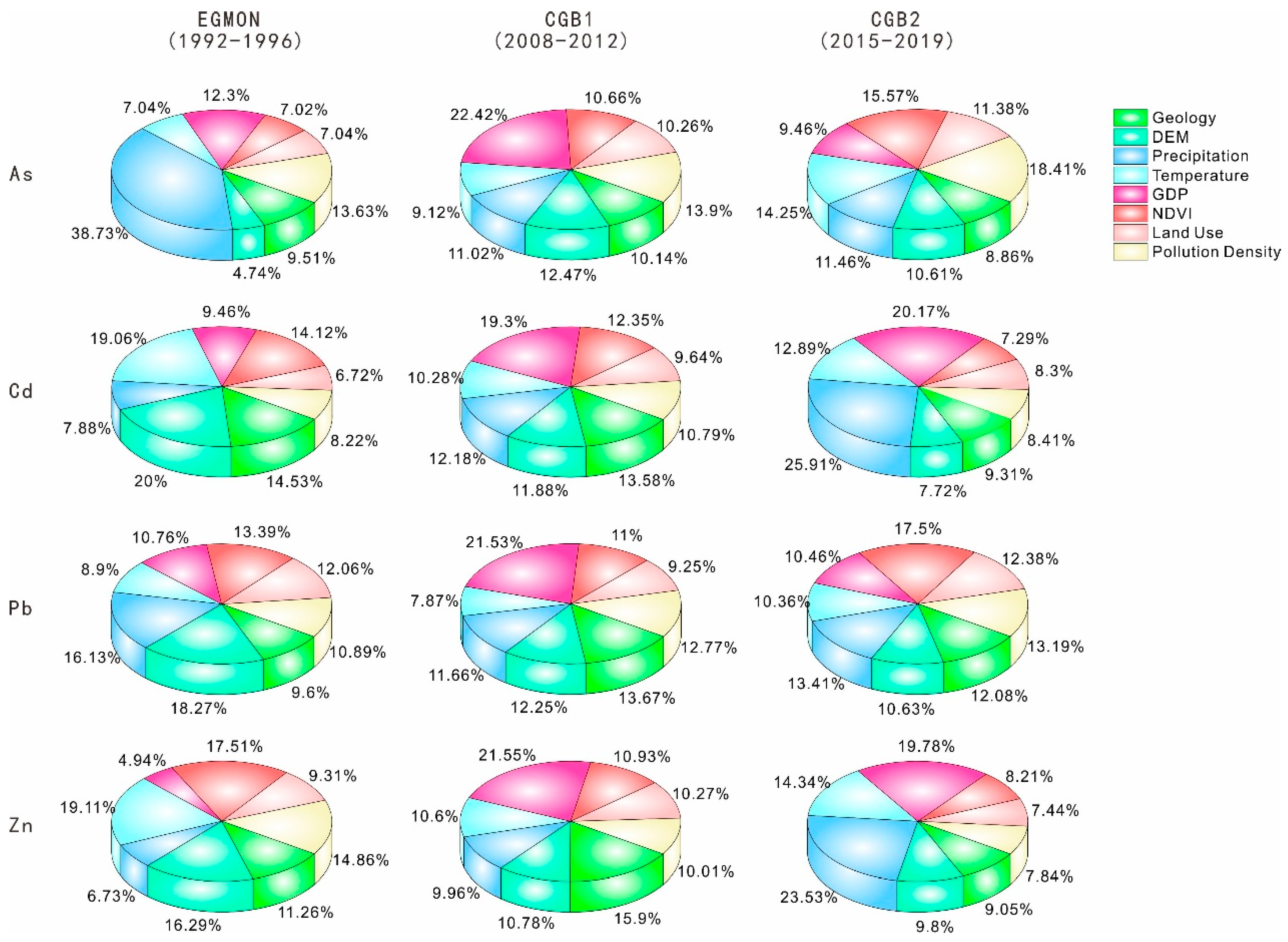
| As | Cd | Pb | Zn | ||
|---|---|---|---|---|---|
| EGMON | Mean | 15.77 | 0.17 | 38.35 | 85.98 |
| CV | 193.49 | 70.45 | 72.28 | 79.51 | |
| Median | 7.80 | 0.13 | 34.50 | 72.00 | |
| Min | 2.10 | 0.05 | 14.00 | 17.50 | |
| Max | 144.00 | 0.47 | 137.00 | 342.00 | |
| CGB1 | Mean | 59.71 | 1.57 | 83.06 | 218.96 |
| CV | 405.67 | 370.00 | 314.10 | 320.28 | |
| Median | 12.58 | 0.26 | 31.04 | 79.42 | |
| Min | 3.12 | 0.10 | 16.10 | 37.96 | |
| Max | 1270.72 | 30.61 | 1385.64 | 3724.96 | |
| CGB2 | Mean | 12.81 | 0.39 | 32.35 | 87.84 |
| CV | 78.07 | 10 | 75.50 | 61.38 | |
| Median | 12.17 | 0.24 | 26.95 | 80.22 | |
| Min | 2.47 | 0.03 | 10.60 | 27.15 | |
| Max | 50.42 | 1.53 | 137.92 | 261.79 |
Disclaimer/Publisher’s Note: The statements, opinions and data contained in all publications are solely those of the individual author(s) and contributor(s) and not of MDPI and/or the editor(s). MDPI and/or the editor(s) disclaim responsibility for any injury to people or property resulting from any ideas, methods, instructions or products referred to in the content. |
© 2023 by the authors. Licensee MDPI, Basel, Switzerland. This article is an open access article distributed under the terms and conditions of the Creative Commons Attribution (CC BY) license (https://creativecommons.org/licenses/by/4.0/).
Share and Cite
Tian, M.; Wang, X.; Zhou, J.; Chi, Q.; Liu, D.; Qiao, Y.; Wu, C.; Zhou, Y.; Wang, Q.; Liu, F. Temporal–Spatial Distributions and Influencing Factors of Heavy Metals As, Cd, Pb, and Zn in Alluvial Soils on a Regional Scale in Guangxi, China. Minerals 2023, 13, 1107. https://doi.org/10.3390/min13081107
Tian M, Wang X, Zhou J, Chi Q, Liu D, Qiao Y, Wu C, Zhou Y, Wang Q, Liu F. Temporal–Spatial Distributions and Influencing Factors of Heavy Metals As, Cd, Pb, and Zn in Alluvial Soils on a Regional Scale in Guangxi, China. Minerals. 2023; 13(8):1107. https://doi.org/10.3390/min13081107
Chicago/Turabian StyleTian, Mi, Xueqiu Wang, Jian Zhou, Qinghua Chi, Dongsheng Liu, Yu Qiao, Chao Wu, Yining Zhou, Qiang Wang, and Futian Liu. 2023. "Temporal–Spatial Distributions and Influencing Factors of Heavy Metals As, Cd, Pb, and Zn in Alluvial Soils on a Regional Scale in Guangxi, China" Minerals 13, no. 8: 1107. https://doi.org/10.3390/min13081107
APA StyleTian, M., Wang, X., Zhou, J., Chi, Q., Liu, D., Qiao, Y., Wu, C., Zhou, Y., Wang, Q., & Liu, F. (2023). Temporal–Spatial Distributions and Influencing Factors of Heavy Metals As, Cd, Pb, and Zn in Alluvial Soils on a Regional Scale in Guangxi, China. Minerals, 13(8), 1107. https://doi.org/10.3390/min13081107





